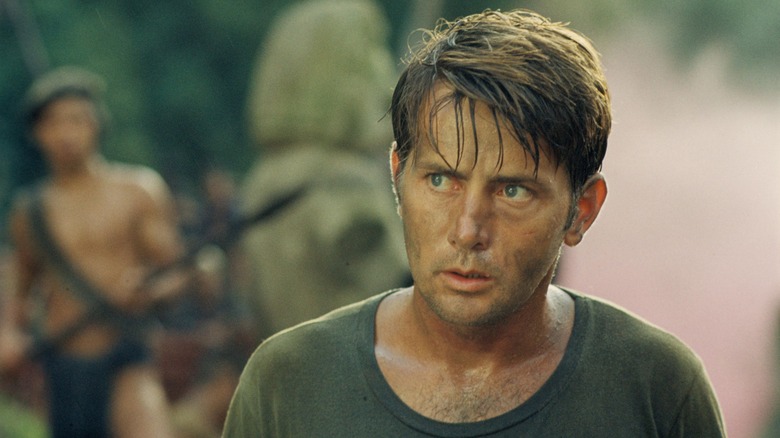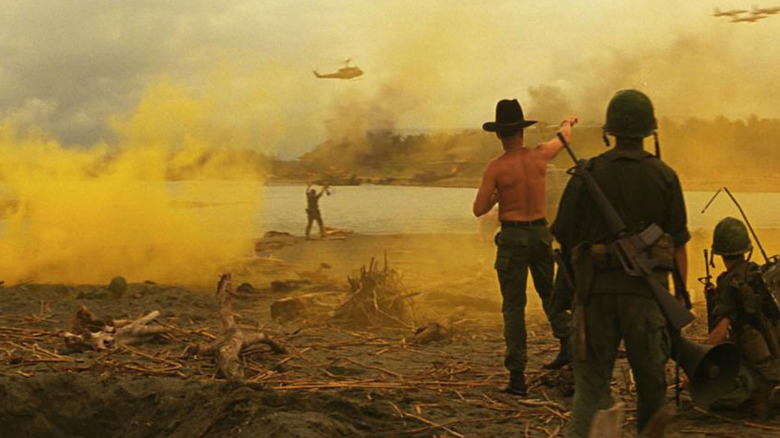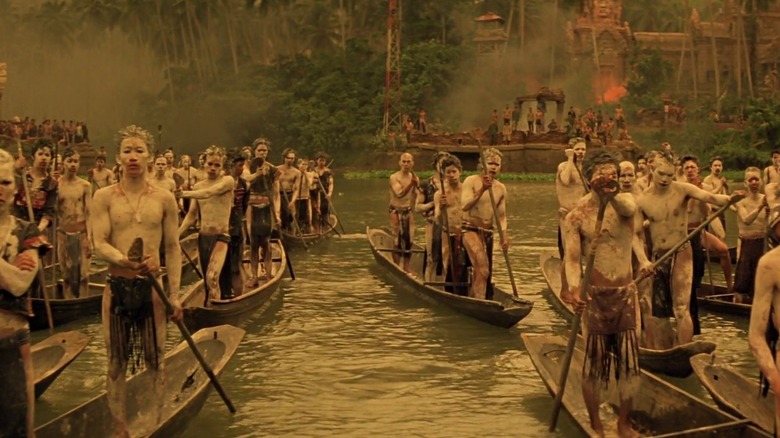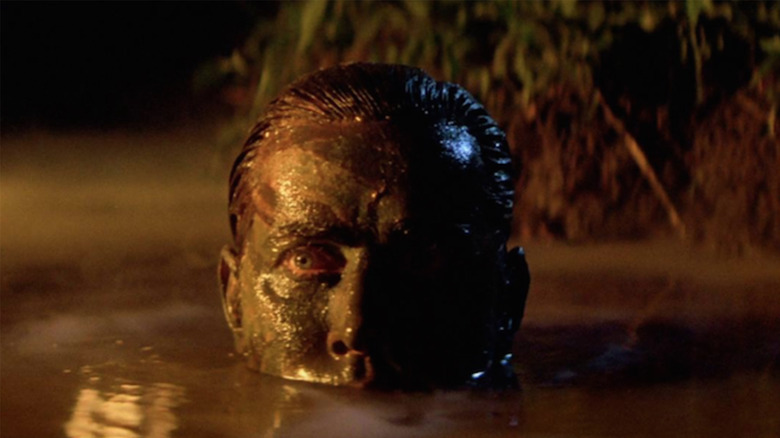How Apocalypse Now Became The Surreal Fever Dream We All Know Today
"Apocalypse Now" is known not just because of its status as a classic war movie but for its controversial production history. Between typhoons destroying sets, actors suffering heart attacks, and a ballooning budget (all on Coppola's dime), Francis Ford Coppola described the making of the film as a "nightmare of not knowing what I was doing, [of] being against outrageous odds" (via GQ). Shooting on location in the wild Philippines jungle and using real helicopters and explosions, Coppola was able to create an authentic Vietnam War experience. But there's another layer to "Apocalypse Now" that makes it a masterpiece.
As filming continued, Coppola, his cinematographer Vittorio Storaro, and art director Angelo P. Graham realized their artistic choices were becoming more and more surrealistic. The beginning of "Apocalypse Now" — with the exception of the hallucinatory opening scene — is fairly grounded, depicting Captain Willard (Martin Sheen) receiving straightforward orders to assassinate the unhinged Colonel Walter Kurtz (Marlon Brando). But as he journeys up the river towards Cambodia, the film becomes a psychedelic fever dream — reflecting the senseless atrocities of the war and its damaging effect on soldiers' psyche. There are several key components that brought Coppola's surrealistic vision to life.
Playing with colors and shadow
In Coppola's breakdown of his most iconic films, he describes the origins of his uncanny style:
"You know, movies are made by many, many things and people, but one of the things that make a movie is the movie. It contributes to making itself. How does that work? Well, if you're throwing smoke grenades and you and the photographer and art director say, 'Gee, that looks good, let's do more of that,' that's what I mean by the movie starts nudging into you and saying, 'Oh, don't go this way, go more this way.' So 'Apocalypse Now' was sort of telling us to make the film be more surrealistic."
The filmmakers were particularly struck by the use of the colored smoke grenades. Their bright splash of color against the muted background obscures the audience's vision and disorients them, making them feel as if they are in some strange fantasy. The arresting opening montage set to The Doors' song "The End" is also illusory. As Willard has a nervous breakdown in his dingy hotel room, Coppola superimposes images of terrifying napalm explosions and helicopter whirling blades over Willard's vacant face, suggesting that he is permanently haunted by his actions in Vietnam. In this scene, and others, Coppola plays with shadow and light to create phantasmagoric compositions.
The further Willard travels up the river, the deeper the darkness becomes, adding a sense of unsettling terror to the discovery of Colonel Kurtz. At the beginning of "Apocalypse Now," most of the scenes are set during the day and lit with vibrant yellow, orange, and green colors. Then it slowly becomes sunset, with dark blues and blacks punctuated by deep golden yellows. By the time Willard meets Colonel Kurtz, the demigod is completely shrouded in twilight, lending a mysterious awe to his philosophical character. The cinematography is one of the strongest elements of surrealism in "Apocalypse Now."
A journey through time
In addition to light and shadow, Coppola's uses a dreamlike narrative structure. The director felt that "Apocalypse Now" would take viewers on a strange "journey through time." He told GQ:
"And we were going through time, and we would end up in the '50s when the French were there. And then we would end up a thousand years before that when the earliest homo sapiens were there in their most original form, which was these Montagnard natives, who were the Ithagau people of Philippines."
In the middle of the tropical forest, Willard and his team run into a ghost-like French plantation. It's a small, isolated section of civilization that willfully ignores the chaos that surrounds them. The soldiers feel bizarre sharing such an abundant feast with the French family after facing the wilderness. The family refuses to move locations, warning Willard that Americans are fighting for the "biggest nothing in history." It's a jarring sequence that widens the film's scope to the overlooked French colonial history of Vietnam. This scene was cut from the final cut of the film but is seen in the redux version.
When Willard finds Kurtz, it's as if he stepped back in time to an ancient world. Indigenous people stoically stand on boats before a ruined temple with red-orange smoke billowing through the palm trees and dead bodies hanging everywhere. They look otherworldly against the disquieting yellow-green light, almost like an old sepia photograph come to life.
'You painted yourself in a corner, didn't you?'
Coppola shared that Marlon Brando remarked on the film's surrealism and how that would affect the film's ending:
'You painted yourself in a corner, didn't you?' Meaning, you had made this movie so surreal that a normal big movie war scene ending, where the other guys come and they fight, isn't gonna work. If you've made the movie go in a very surreal direction, you're gonna have to think of a resolution that is surreal, or that can at least have resonance without being a typical, well, the army comes, there was a big battle and it's an exciting battle and then it's over."
Instead, the film ends with a one-on-one skirmish between Captain Willard and Colonel Kurtz. In an iconic shot, Willard camouflages himself with dark face paint and rises out of the muddy river to surreptitiously slaughter Kurtz with a machete inside the ancient temple. "The End" by The Doors blasts, adding to the violent anarchy. Coppola intercuts Kurtz's murder with a bloody animal sacrifice to emphasize the primitive nature of their combat. Willard returns to the boat on a voyage back to the modern world — never fully leaving behind the horrors of Vietnam.



